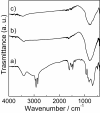Unique and facile solvothermal synthesis of mesoporous WO3 using a solid precursor and a surfactant template as a photoanode for visible-light-driven water oxidation
- PMID: 25313301
- PMCID: PMC4194058
- DOI: 10.1186/1556-276X-9-542
Unique and facile solvothermal synthesis of mesoporous WO3 using a solid precursor and a surfactant template as a photoanode for visible-light-driven water oxidation
Abstract
Mesoporous tungsten trioxide (WO3) was prepared from tungstic acid (H2WO4) as a tungsten precursor with dodecylamine (DDA) as a template to guide porosity of the nanostructure by a solvothermal technique. The WO3 sample (denoted as WO3-DDA) prepared with DDA was moulded on an electrode to yield efficient performance for visible-light-driven photoelectrochemical (PEC) water oxidation. Powder X-ray diffraction (XRD) data of the WO3-DDA sample calcined at 400°C indicate a crystalline framework of the mesoporous structure with disordered arrangement of pores. N2 physisorption studies show a Brunauer-Emmett-Teller (BET) surface area up to 57 m(2) g(-1) together with type IV isotherms and uniform distribution of a nanoscale pore size in the mesopore region. Scanning electron microscopy (SEM) images exhibit well-connected tiny spherical WO3 particles with a diameter of ca. 5 to 20 nm composing the mesoporous network. The WO3-DDA electrode generated photoanodic current density of 1.1 mA cm(-2) at 1.0 V versus Ag/AgCl under visible light irradiation, which is about three times higher than that of the untemplated WO3. O2 (1.49 μmol; Faraday efficiency, 65.2%) was evolved during the 1-h photoelectrolysis for the WO3-DDA electrode under the conditions employed. The mesoporous electrode turned out to work more efficiently for visible-light-driven water oxidation relative to the untemplated WO3 electrode.
Keywords: Mesoporous structure; Photoelectrocatalysis; Tungsten trioxide; Water oxidation.
Figures






Similar articles
-
Dual-Functional Surfactant-Templated Strategy for Synthesis of an In Situ N2 -Intercalated Mesoporous WO3 Photoanode for Efficient Visible-Light-Driven Water Oxidation.Chemistry. 2017 May 11;23(27):6596-6604. doi: 10.1002/chem.201700088. Epub 2017 Apr 18. Chemistry. 2017. PMID: 28249104
-
Temperature-Controlled Transformation of WO3 Nanowires into Active Facets-Exposed Hexagonal Prisms toward Efficient Visible-Light-Driven Water Oxidation.ACS Appl Mater Interfaces. 2023 May 3;15(17):20885-20896. doi: 10.1021/acsami.2c22483. Epub 2023 Apr 21. ACS Appl Mater Interfaces. 2023. PMID: 37083342
-
Controllable Synthesis of N2-Intercalated WO3 Nanorod Photoanode Harvesting a Wide Range of Visible Light for Photoelectrochemical Water Oxidation.Molecules. 2023 Mar 27;28(7):2987. doi: 10.3390/molecules28072987. Molecules. 2023. PMID: 37049750 Free PMC article.
-
Fabrication of an Efficient N, S Co-Doped WO3 Operated in Wide-Range of Visible-Light for Photoelectrochemical Water Oxidation.Nanomaterials (Basel). 2022 Jun 16;12(12):2079. doi: 10.3390/nano12122079. Nanomaterials (Basel). 2022. PMID: 35745417 Free PMC article.
-
Platinum/mesoporous WO3 as a carbon-free electrocatalyst with enhanced electrochemical activity for methanol oxidation.J Phys Chem B. 2008 Sep 25;112(38):12024-31. doi: 10.1021/jp803565k. Epub 2008 Aug 28. J Phys Chem B. 2008. PMID: 18754636
References
LinkOut - more resources
Full Text Sources
Other Literature Sources

